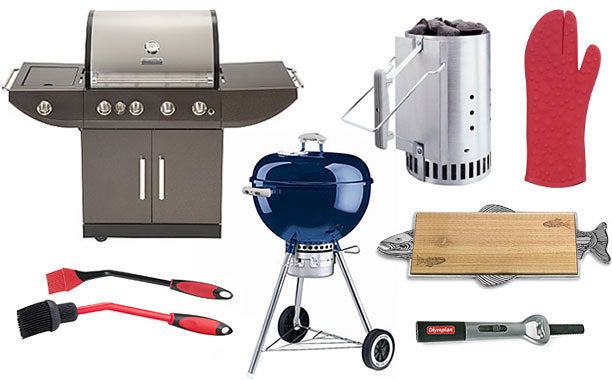
To most Americans, barbecue sauce is red and sweet and it comes from a shelf near the ketchup. To those of us who travel and would rather lunch out back of a rickety shack under a shade tree rather than under the golden arches, barbecue sauce comes in a rainbow of colors and flavors, and they are tied to the area of origin.
In half of North Carolina barbecue sauce is practically clear with cayenne pepper flakes that flurry in it like a snow globe. In other parts of the state it is practically pink. In much of South Carolina it is yellow. In many dingy brown joints of Texas it is close to brown with big chunks of green peppers and other flotsam in it. And in a corner of North Alabama it is white with black pepper flecks. In Memphis the "sauce" comes from a shaker and is no more liquid than the paprika that is its backbone.
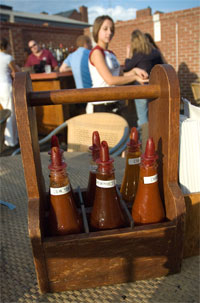 That's because barbecue has evolved along disparate paths around the nation, led down these trails by the racial and ethnic immigrants who settled there. Indeed, barbecue sauce is a cultural phenomenon.
That's because barbecue has evolved along disparate paths around the nation, led down these trails by the racial and ethnic immigrants who settled there. Indeed, barbecue sauce is a cultural phenomenon.
To the cook, barbecue sauce is alchemy. It is downright fun to make. Standing over the pot adding a dash of this, a pinch of that, taking a taste, adjusting, tasting, and adding something else makes one feel like a wizard. To add a personal flair to your next cookout, serve your homemade sauce from a jelly jar and be prepared to take a few bows. If you feel ambitious, serve your guests a choice of several sauces and repeat what you read here.
Below are the nine classic American barbecue sauces (if we stretch the definition of "sauce" to include Memphis dry rubs). Click the links for my recipes if you want to make your own. If you want to taste examples of these styles but don't want to make them, click here for a list of my favorite commercial barbecue sauces.
The Nine Styles of American Barbecue Sauce
 1) Kansas City Sweet Sauce. By far the most popular style of barbecue sauce, this is the classic rich, sweet-tart, tomato-based sauce often sweetened with molasses or brown sugar and balanced with the tartness of vinegar. Many have liquid smoke to help get that outdoor flavor for folks who cannot cook outdoors. But beware: Most commercial sauces labeled Kansas City sauce are waaaaaay too sweet. If you pick up a bottle in the grocery labeled Kansas City Style Barbecue Sauce", and sugar or high fructose corn syrup are the first ingredients on the label, put it down. KC sauces don't penetrate the meat well, and sit on top like frosting. But they caramelize beautifully over a hot fire making a crisp coat. They also burn easily, so coat your meat no sooner than 10 minutes before serving. Try my Kansas City Classic Sauce.
1) Kansas City Sweet Sauce. By far the most popular style of barbecue sauce, this is the classic rich, sweet-tart, tomato-based sauce often sweetened with molasses or brown sugar and balanced with the tartness of vinegar. Many have liquid smoke to help get that outdoor flavor for folks who cannot cook outdoors. But beware: Most commercial sauces labeled Kansas City sauce are waaaaaay too sweet. If you pick up a bottle in the grocery labeled Kansas City Style Barbecue Sauce", and sugar or high fructose corn syrup are the first ingredients on the label, put it down. KC sauces don't penetrate the meat well, and sit on top like frosting. But they caramelize beautifully over a hot fire making a crisp coat. They also burn easily, so coat your meat no sooner than 10 minutes before serving. Try my Kansas City Classic Sauce.
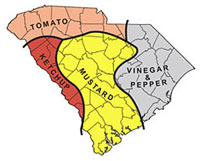 2) South Carolina Mustard Sauce. In South Carolina barbecue is not chicken, burgers, hot doges, ore even ribs. Barbecue is pork, often whole hog, cooked low and slow, and chopped or pulled into succulent shards, and crowned with sauce. Nowhere are there more regional sauces than South Carolina. In the eastern part of the state, on the North Carolina border, there is a sauce that is mostly vinegar, cayenne pepper, and black pepper that is similar to the East Carolina mop-sauce (below). There is a variant laced with tomato sauce popular in the northern Hill Country similar to the Lexington and Hill Country sauce from North Carolina. And there is a ketchup based sauce similar to Kansas City sauce. But the most distinctive, and by far my fave, is the mustard based sauce. Mustard and pork go together like peanut butter and jelly. Early German immigrants in South Carolina knew this. The classic SC mustard sauces found in barbecue joints from Columbia to Charleston are mostly runny yellow mustard, vinegar, sugar, and spices. Simple but very effective. The names of many of the best barbecue joints that serve mustard sauce have German names: Shealy, Sweatman, Meyer, and Zeigler. They are especially good on pulled pork. I offer two versions, South Carolina Mustard Sauce is the classic while my personal riff on the theme, Grownup Mustard Sauce, is a more complex, herbal variation on the theme.
2) South Carolina Mustard Sauce. In South Carolina barbecue is not chicken, burgers, hot doges, ore even ribs. Barbecue is pork, often whole hog, cooked low and slow, and chopped or pulled into succulent shards, and crowned with sauce. Nowhere are there more regional sauces than South Carolina. In the eastern part of the state, on the North Carolina border, there is a sauce that is mostly vinegar, cayenne pepper, and black pepper that is similar to the East Carolina mop-sauce (below). There is a variant laced with tomato sauce popular in the northern Hill Country similar to the Lexington and Hill Country sauce from North Carolina. And there is a ketchup based sauce similar to Kansas City sauce. But the most distinctive, and by far my fave, is the mustard based sauce. Mustard and pork go together like peanut butter and jelly. Early German immigrants in South Carolina knew this. The classic SC mustard sauces found in barbecue joints from Columbia to Charleston are mostly runny yellow mustard, vinegar, sugar, and spices. Simple but very effective. The names of many of the best barbecue joints that serve mustard sauce have German names: Shealy, Sweatman, Meyer, and Zeigler. They are especially good on pulled pork. I offer two versions, South Carolina Mustard Sauce is the classic while my personal riff on the theme, Grownup Mustard Sauce, is a more complex, herbal variation on the theme.
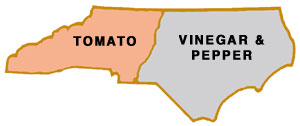 3) East Carolina Mop-Sauce. As in South Carolina, North Carolina barbecue is either chopped or pulled pork. Nothing else. And the whole hog is committed. On the coast of North and South Carolina, a.k.a. "East Carolina" or the "Low Country", the philosophy is: "Keep the mustard for your hot dogs and the ketchup for your fries." The African slaves of the Scottish settlers in the region pioneered American barbecue and their simple sauces were plain a kiss of hot pepper flakes and ground black pepper in vinegar. And so they remain today where the sauce is used both as a mop, or baste, on the meat while it is cooking, and then as a finishing sauce at tableside. Thin and piquant, they are designed to penetrate the meat, not just sit on top as thicker ketchup and mustard sauces do. They do a great job of cutting the fat in lipid-laced pork. There is little or no sugar in the mix, so your kids will hate it. Try my East Carolina Kiss & Vinegar on just a bit of your chopped pork before your pour it over the whole sandwich, and if you don't like it, send the leftovers to me.
3) East Carolina Mop-Sauce. As in South Carolina, North Carolina barbecue is either chopped or pulled pork. Nothing else. And the whole hog is committed. On the coast of North and South Carolina, a.k.a. "East Carolina" or the "Low Country", the philosophy is: "Keep the mustard for your hot dogs and the ketchup for your fries." The African slaves of the Scottish settlers in the region pioneered American barbecue and their simple sauces were plain a kiss of hot pepper flakes and ground black pepper in vinegar. And so they remain today where the sauce is used both as a mop, or baste, on the meat while it is cooking, and then as a finishing sauce at tableside. Thin and piquant, they are designed to penetrate the meat, not just sit on top as thicker ketchup and mustard sauces do. They do a great job of cutting the fat in lipid-laced pork. There is little or no sugar in the mix, so your kids will hate it. Try my East Carolina Kiss & Vinegar on just a bit of your chopped pork before your pour it over the whole sandwich, and if you don't like it, send the leftovers to me.
4) Lexington Dip (a.k.a. Western Carolina or Piedmont Dip). In Lexington and in the "Piedmont" hilly areas of western North Carolina they prefer to make their barbecue from the pig's shoulder, a rich flavorful clod of meat. In North Carolina, otherwise kindly old men have been moved to fisticuffs over the question of whether barbecue is properly made from whole hog or shoulder. In Lexington and the west, they often call their mop-sauce "dip". It is vinegar and pepper based, a lot like the East Carolina mop-sauce, but laced with a hint of tomato sauce or ketchup. The red stuff helps tame the fierceness of the vinegar a bit, and the hint of sweetness counterbalances the acidity. I prefer Lexington Dip slightly to the East Carolina style.
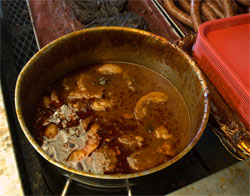 5) Texas Mop-Sauce. In Texas they barbecue pork and beef ribs, pulled pork, chicken, mutton, goat, and sausage they call "hot guts", but the star of the Lone Star State is beef brisket, an impossibly tough cut from the chest area that is magically converted to buttah-like tenderness with 12-18 hours of low and slow smoke roasting. There are three important culinary influences on Texas barbecue: (1) European immigrants who brought expertise in smoking meats, especially Germans, Czechs, and Hungarians (2) freed slaves from the Southeast, and (3) Mexicans (Texas was, after all, a part of Mexico, and its cuisine leans heavily on Spanish, Mayan, and Aztec cultures). Most Texas sauces are fashioned to complement beef brisket first and they are not very sweet. Some traditional Texas pitmasters use their sauce as both a mop to cool and moisten the meat during direct cooking, and as an optional finishing sauce. Most common are thin, tart mops that are flavored with vinegar, chili powder or ancho powder, lots of black pepper, cumin, hot sauce, fresh onion, and only a touch of ketchup. Some of the best sauces have beef drippings, and therefore cannot be bottled. The stuff served in the traditional old restaurants is vastly different than the stuff sold in bottle. In hallowed joints like Cooper's, in Llano, the great Texas Mop-Sauce often resembles a thin tomato soup with a beef stock base. They penetrate the meat easily rather than sit on top. I prefer them on brisket, not pork. In this picture, the bottled sauce sold at Cooper's is poured into a large pot and is kept warm on the holding pit. Trimmings are tossed in the pot, and when you order, if you ask for sauce, the meat is dipped in the pot. It tastes a lot different than the bottled sauce served on the tables. Before the meat is cooked, it is seasoned with a Texas dry rub, formulated for brisket with little or no sugar, lots of black pepper, and so they are very different from Memphis and most other rubs.
5) Texas Mop-Sauce. In Texas they barbecue pork and beef ribs, pulled pork, chicken, mutton, goat, and sausage they call "hot guts", but the star of the Lone Star State is beef brisket, an impossibly tough cut from the chest area that is magically converted to buttah-like tenderness with 12-18 hours of low and slow smoke roasting. There are three important culinary influences on Texas barbecue: (1) European immigrants who brought expertise in smoking meats, especially Germans, Czechs, and Hungarians (2) freed slaves from the Southeast, and (3) Mexicans (Texas was, after all, a part of Mexico, and its cuisine leans heavily on Spanish, Mayan, and Aztec cultures). Most Texas sauces are fashioned to complement beef brisket first and they are not very sweet. Some traditional Texas pitmasters use their sauce as both a mop to cool and moisten the meat during direct cooking, and as an optional finishing sauce. Most common are thin, tart mops that are flavored with vinegar, chili powder or ancho powder, lots of black pepper, cumin, hot sauce, fresh onion, and only a touch of ketchup. Some of the best sauces have beef drippings, and therefore cannot be bottled. The stuff served in the traditional old restaurants is vastly different than the stuff sold in bottle. In hallowed joints like Cooper's, in Llano, the great Texas Mop-Sauce often resembles a thin tomato soup with a beef stock base. They penetrate the meat easily rather than sit on top. I prefer them on brisket, not pork. In this picture, the bottled sauce sold at Cooper's is poured into a large pot and is kept warm on the holding pit. Trimmings are tossed in the pot, and when you order, if you ask for sauce, the meat is dipped in the pot. It tastes a lot different than the bottled sauce served on the tables. Before the meat is cooked, it is seasoned with a Texas dry rub, formulated for brisket with little or no sugar, lots of black pepper, and so they are very different from Memphis and most other rubs.
 6) Tennessee Whiskey Sauce. The Jack Daniel's World Championship Invitational Barbecue is considered by many to be the most prestigious competition in the world. As do many competitions, they have a sauce category, but theirs has a twist: Jack Daniels whiskey must be in the blend. Well, just as they planned it, whiskey-laced sauces have spread across the nation. There are so many that I think it must be considered a legitimate category of barbecue sauce. My recipe for Tennessee Hollerin' Whiskey Sauce is named after the hollow, a lowland by the creek in which it was invented, this rich sauce has a kick, and when you taste it you'll bend over and holler "Kick me!" The secret: Whiskey concentrate.
6) Tennessee Whiskey Sauce. The Jack Daniel's World Championship Invitational Barbecue is considered by many to be the most prestigious competition in the world. As do many competitions, they have a sauce category, but theirs has a twist: Jack Daniels whiskey must be in the blend. Well, just as they planned it, whiskey-laced sauces have spread across the nation. There are so many that I think it must be considered a legitimate category of barbecue sauce. My recipe for Tennessee Hollerin' Whiskey Sauce is named after the hollow, a lowland by the creek in which it was invented, this rich sauce has a kick, and when you taste it you'll bend over and holler "Kick me!" The secret: Whiskey concentrate.
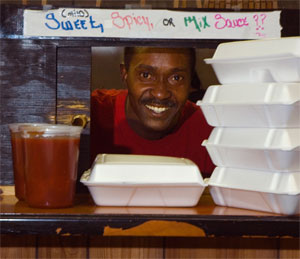 7) Louisiana Hot Dippin' Sauce. In Louisiana anything that can be put on a grill is called barbecue, from fish to crawfish to nutria (kinda like a rat). In Louisiana, hot sauce goes on everything. The first bottled hot sauces came out of Louisiana, home of Tabasco Sauce. Nowadays there are lots of great hot and spicy barbecue sauces on the market. Some just burn from capsaicin (the active ingredient in chili peppers), but the best are blends of several different kinds of heat, among them: Black pepper, white pepper, mustard, wasabi, several different kinds of chilis, plus an underlying flavor of the meat of the chili pepper. The heat is then usually tempered with tomato sauce, and often countered with sweetness. Bayou Bite, my version of a Louisiana barbecue sauce is a wonderful blend of sweet and hot peppers used as a finishing sauce, after the meat is cooked, or as a dipping sauce served with the meat. Even if you don't like hot stuff, you really should try this one.
7) Louisiana Hot Dippin' Sauce. In Louisiana anything that can be put on a grill is called barbecue, from fish to crawfish to nutria (kinda like a rat). In Louisiana, hot sauce goes on everything. The first bottled hot sauces came out of Louisiana, home of Tabasco Sauce. Nowadays there are lots of great hot and spicy barbecue sauces on the market. Some just burn from capsaicin (the active ingredient in chili peppers), but the best are blends of several different kinds of heat, among them: Black pepper, white pepper, mustard, wasabi, several different kinds of chilis, plus an underlying flavor of the meat of the chili pepper. The heat is then usually tempered with tomato sauce, and often countered with sweetness. Bayou Bite, my version of a Louisiana barbecue sauce is a wonderful blend of sweet and hot peppers used as a finishing sauce, after the meat is cooked, or as a dipping sauce served with the meat. Even if you don't like hot stuff, you really should try this one.
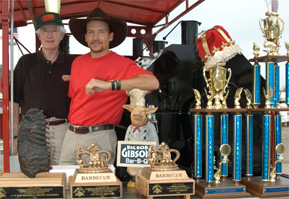 8) Alabama White Sauce. Developed for chicken by Big Bob Gibson's Bar-B-Q in Decatur, Alabama, this mayonnaise and vinegar sauce has become so well known among barbecue fans that it has generated many admirers and a handful of imitators. I don't recommend it for pork, and not everyone likes it on chicken, but it is so popular in Alabama it must be consider a regional classic. Chris Lilly, of Big Bob's says my attempt to reverse engineer his Alabama White Sauce is "scary close".
8) Alabama White Sauce. Developed for chicken by Big Bob Gibson's Bar-B-Q in Decatur, Alabama, this mayonnaise and vinegar sauce has become so well known among barbecue fans that it has generated many admirers and a handful of imitators. I don't recommend it for pork, and not everyone likes it on chicken, but it is so popular in Alabama it must be consider a regional classic. Chris Lilly, of Big Bob's says my attempt to reverse engineer his Alabama White Sauce is "scary close".
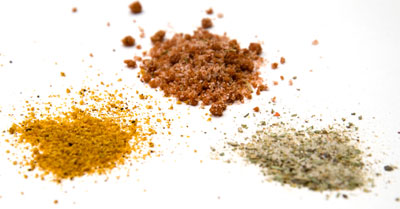 9) Memphis Dry Rub. Memphis is second only to Kansas City as a town of barbecue renown. Ribs and pulled pork are the stars, although their local special, perhaps best called their local oddity, is barbecue spaghetti. No, they don't put the pasta on the pit, it's just doused with barbecue sauce. Alas, there is no distinctive indigenous Memphis sauce style. Around the nation a lot of pit stops call their sauce Memphis style, but they're kidding themselves and us. In fact, many Memphis purists prefer their ribs "dry" with only a spice rub. A restaurant's gotta have confidence in its meat to serve it with spices only and no sauce. Many Memphis restaurants have bowed to public demand and now offer a choice: Dry or wet, with wet usually meaning a Kansas City-style tomato-based sauce perhaps a bit thinner, more vinegary. Memphis dry rubs are usually paprika based, and typical ingredients are salt, garlic, onion, black pepper, chili powder, and oregano. "Meathead's Magic Dust" is a very versatile rub perfect for ribs, but readers have told me they love it on everything from turkey to salmon. Perhaps the most revered dry ribs are served at Charlie Vergos' Rendezvous (called "The Vous" by the locals). There are a lot of recipes on the Internet that the owners have palmed off on gullible media. They aren't close. I've reversed engineered Rendezvous-style Memphis Dry Rub, and my recipe is a LOT closer to the real deal.
9) Memphis Dry Rub. Memphis is second only to Kansas City as a town of barbecue renown. Ribs and pulled pork are the stars, although their local special, perhaps best called their local oddity, is barbecue spaghetti. No, they don't put the pasta on the pit, it's just doused with barbecue sauce. Alas, there is no distinctive indigenous Memphis sauce style. Around the nation a lot of pit stops call their sauce Memphis style, but they're kidding themselves and us. In fact, many Memphis purists prefer their ribs "dry" with only a spice rub. A restaurant's gotta have confidence in its meat to serve it with spices only and no sauce. Many Memphis restaurants have bowed to public demand and now offer a choice: Dry or wet, with wet usually meaning a Kansas City-style tomato-based sauce perhaps a bit thinner, more vinegary. Memphis dry rubs are usually paprika based, and typical ingredients are salt, garlic, onion, black pepper, chili powder, and oregano. "Meathead's Magic Dust" is a very versatile rub perfect for ribs, but readers have told me they love it on everything from turkey to salmon. Perhaps the most revered dry ribs are served at Charlie Vergos' Rendezvous (called "The Vous" by the locals). There are a lot of recipes on the Internet that the owners have palmed off on gullible media. They aren't close. I've reversed engineered Rendezvous-style Memphis Dry Rub, and my recipe is a LOT closer to the real deal.
Saucing Strategies
Mop-sauces are splashed on throughout the cook, but many sauces contain sugar and can burn quickly, so the secret is to hold off on the sauce until the last 10 minutes. Click here for more on saucing strategies.
Commercial Barbecue Sauces
Sometimes it seems as if every rib joint in the country is bottling its sauce and selling it on the internet. My tongue has been marinating in them for years and, since you asked, I'd be glad to recommend a few. Click here to see some of my favorite regional sauces and how to get them.
Text and photos Copyright (c) 2009 By Craig "Meathead" Goldwyn, AmazingRibs.com, and all rights are reserved. Click here for information on reprint rights.